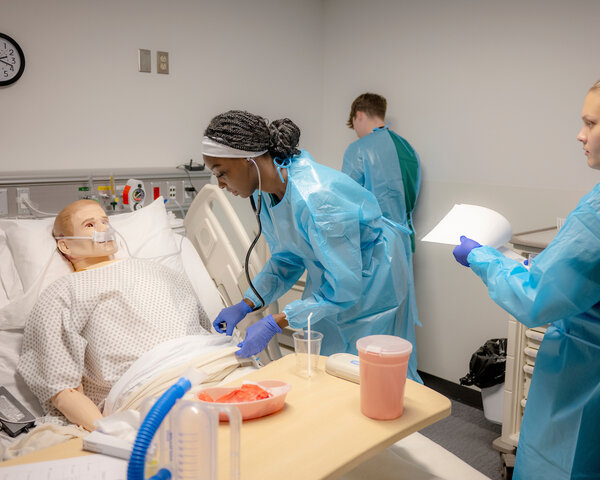Not long ago, Ohio’s nursing workforce appeared to be on a path to recovery thanks to an influx of younger nurses entering the profession. But the COVID-19 pandemic changed everything, accelerating a shortage that now threatens to leave hospitals critically understaffed and patients in jeopardy. With 9,000 RN positions unfilled across the state, health care leaders are scrambling to address the crisis.
Ohio, like much of the United States, is confronting a severe nursing shortage that threatens patient care and the well-being of health care workers, leaving hospitals understaffed. A 2023 study by the National Council of State Boards of Nursing (opens in a new window) revealed that approximately 100,000 nurses exited the profession during the pandemic, with another 610,000 planning to leave by 2027. Although it was predicted that there would be stagnation of nurses starting in the 1990s due to the retirement of baby boomers, the rate in which nurses are leaving the profession post-pandemic has skyrocketed to severe levels.
According to a study in Health Affairs (opens in a new window), the U.S. nursing workforce even saw a glimpse of revived growth when millennials started entering the field in the early 2000s with the number of registered nurses rising to 3.2 million by 2020, representing a doubling of per capita nurses since 1982—from 52 to 100 nurses per 10,000 residents. However, this start back toward stability was significantly disrupted by the COVID-19 pandemic. The nursing workforce, which had plateaued in the early months of the pandemic, experienced more than 100,000 nurses dropping from the profession—a loss unparalleled in the past four decades.
The Ohio Nurses Association (ONA) also recently released findings (opens in a new window) from a survey indicating that 63% of direct care nurses are considering leaving bedside roles due to overwhelming patient loads, insufficient staffing and workplace violence incidents. Furthermore, the survey highlighted that 63% of nurses who have already left the bedside did so because of patient care load, exacerbating the mental and physical toll on health care workers.
“Ohio is experiencing a pronounced nursing shortage, which has become evident through numerous factors,” said Char Miller, executive director of Nursing in OHIO’s College of Health Sciences and Professions. “There are currently around 9,000 RN positions open across the state. The shortage has impacted every clinical partner we work with, all of whom emphasize their need for more nurses. It is a serious problem that needs addressed to ensure proper health care.”
Factors contributing to nursing shortages
There is not one root cause of the problem; rather, several key factors contribute to the growing shortage.
According to Miller and Dr. Ilana Chertok, professor and associate director of Nursing Research and Scholarship in OHIO’s College of Health Science and Professions, the main factors include nursing and patient population issues, work conditions, violence in the workplace, the impact of the COVID-19 pandemic and education.
“As nurses age, they are retiring from the clinical and academic settings without sufficient replacement by the next generation of educated and trained nurses,” Chertok explained. “The overall patient population is aging and has more co-morbidities, which increases their health needs. The increase in chronic disease, including obesity, diabetes and heart disease, increases the burden on the health care system, including on the workforce.”
According to Miller, the nursing shortage, which first emerged in the late 1990s, is projected to reach critical levels by 2025, with a significant gap between the demand for nurses and the available workforce.
“We were already facing a shortage due to the retirement of baby boomers, a generation that has created a substantial demand as they age,” Miller added. “But the COVID-19 pandemic further intensified the crisis, with many nurses leaving the profession, especially those working in acute care settings where the intensity and demands are highest. The nurses leaving the field were mid-career, a critical segment of experienced professionals who not only deliver care but also serve as mentors to newer nurses. Losing this group has been devastating, creating a cycle where we lack both new nurses and the seasoned nurses necessary to guide them. This shortage has a cascading effect, straining health care systems across the state as they struggle to provide adequate patient care.”
Chertok also states that the high patient-to-nurse ratios causes demanding workloads, increased risk of burnout, lower job satisfaction and higher rates of turnover.
“There is a lack of administrative support, tough working conditions and a lack of equipment,” she noted. “Health resource disparities, limited specialists and specialty care, and lower salaries in rural and underserved areas exacerbate the work conditions and increased risk of burnout. This issue is an especially difficult challenge in rural and underserved regions.”
The COVID-19 pandemic also caused a sudden surge in the demand for nurses, workload, stress and stress levels, not to mention the high risk of infection for nurses working in clinical settings, which further impacted the nurses and other health care team members.
“The nursing shortage in Ohio is heightened by a variety of interconnected issues, many of which became apparent during the COVID-19 pandemic,” said Dan Skinner, a professor of health policy in OHIO’s Heritage College of Osteopathic Medicine. “This period highlighted long-standing problems like burnout, workplace abuse and inadequate respect and compensation for nurses. For many, COVID-19 acted as a ‘canary in the coal mine,’ signaling deeper systemic issues within the health care system.”
In addition to the factors above, nursing faculty shortages limit the capacity of students that schools can admit and limit the impact on health research and education. According to Chertok, growing faculty shortages related to low salaries, decreasing proportion of faculty completing research or educational doctorates, and aging nursing faculty nearing retirement add to the insufficient number of nursing faculty members available to help mentor and teach the next generation of nursing experts.

The impact on patient care
This shortage is also affecting health care delivery and could have long-term effects on patient outcomes. Health care facilities nationwide have been implementing various strategies including retention bonuses, expanded training programs and flexible work arrangements to address the crisis, but with mixed results. In Ohio, the ONA (opens in a new window) warns that without immediate intervention, the current shortage could worsen, jeopardizing patient care and adding strain on remaining health care providers who are already overburdened.
“Research consistently highlights that nursing shortages can lead to poorer patient outcomes and compromised safety,” Miller added. “Every patient deserves dedicated nursing care, yet as the nursing workforce dwindles, quality, safety and patient satisfaction are significantly impacted.”
According to a study published in the National Institute of Nursing Research (Lasater, Aiken, Sloane, et al. 2021), (opens in a new window) research showed that among 87 acute care hospitals in Illinois, lower patient-to-nurse staffing ratios (of approximately 4:1) reduced the risk of mortality, lowered lengths of stay and was cost-saving for hospitals.
“Nursing shortages negatively impact health care quality, access to health care, wait-times for care, health care deserts and disparity in care, which then negatively impacts the morbidity and mortality of our patients across health care settings,” Chertok explained.
As nurse-to-patient ratios decline, the likelihood of errors rise and patient satisfaction drops, underscoring the direct relationship between sufficient staffing and positive health care outcomes. People are also living longer, which adds to the number of complexities that nurses must care for, both in terms of the number of patients they may be seeing and the care they need.
“Ohio’s aging population adds another layer of complexity. As people live longer with chronic illnesses that require specialized, prolonged care, health care professionals face new challenges in providing adequate support,” Skinner explained.

Katie McClead
A look at Ohio
Recently, Ohio House Bill 452 (opens in a new window) passed, which advocates for reducing the risk of workplace violence and improved safety of health care providers in Ohio. Yet, the Ohio House Bill 285 (opens in a new window), “Nurse Workforce & Safe Patient Care Act,” is still being discussed. The bill aims to improve nurse staffing ratios to prioritize patient safety and high-quality, patient-centered care.
Ohio also faces barriers related to health care licensing and pay. Many qualified professionals from other countries live in Ohio but are unable to practice due to licensure restrictions, even as the state grapples with a shortage of providers.
According to Skinner, many new nurses are also leaving Ohio for states with higher wages and better support.
“While the demand for skilled nurses continues to grow, stagnant wages and insufficient benefits fail to reflect the complexity and importance of their roles. Without addressing these pay disparities, Ohio risks an even greater exodus of nurses leaving to go to other states to practice,” Skinner added.

Ensuring a sustainable future for nurses
Luckily, there is strong interest in the field, with students still pursuing and filling up nursing programs. Ohio University alone is noticing a renewed interest in nursing education, with OHIO’s associate degree programs seeing an increase in applicants, especially in regional and rural areas. Many clinical partners are also offering scholarships and incentives like sign-on bonuses, relocation assistance and guaranteed job placements to attract and retain nurses.
However, the challenge lies in recruiting and retaining individuals who have spent time, energy and money pursuing this education, ensuring they use their degrees after graduating and contribute meaningfully to the industry without facing burnout.
“We’ve seen rising interest in our local associate degree programs, which are accessible in regional areas and will soon expand to our Lancaster campus,” Miller said. “This is encouraging, as many graduates of associate programs tend to stay and serve in their local communities. Locally, we are also seeing innovative efforts and incentives aimed to not only attract new staff but also help retain the skilled nurses currently in the workforce.”
To best train and attract students, OHIO’s School of Nursing has integrated technology into its programs and offers many online learning options, keeping pace with the technological advancements in the health care setting, affording students the skills and training they need to be successful in the professional field.
“Being located in a state with both rural and urban settings, the School of Nursing offers approaches to care that fit the diverse populations,” Chertok explained. “There is a focus on reducing health disparities and promoting health equity, which is critical to meeting the needs of the people of the state and the region.”
OHIO also offers simulations for nursing students to help with hands-on, clinical experience that may be harder to get access to within rural Ohio.
Recently, Ohio University’s Online Psychiatric-Mental Health Nurse Practitioner (PMHNP) program has earned the distinction of being ranked No. 1 (opens in a new window) for 2025 by Nurse Practitioner Online (opens in a new window), a leading resource for aspiring nurse practitioners. OHIO’s nursing program has also been recognized for its excellence, earning the No. 1 spot for public universities in Ohio by nursing.org, (opens in a new window) and ranking No. 3 among both public and private universities, among many other accolades.

